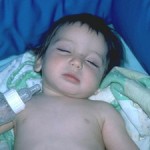Breath Holding Spells in Infants
 Breath holding spells are reported in about 5% of babies between the ages of 6 and 18 months. However, in some cases the child may continue to hold his breath till the age of five years. After that this is very rare. A breath holding spell is often confused with seizure disorder. The most common cause as per the researchers is due to frustration because of disciplining by parents. Breath holding spells syndrome in infants can broadly be classified into four types:
Breath holding spells are reported in about 5% of babies between the ages of 6 and 18 months. However, in some cases the child may continue to hold his breath till the age of five years. After that this is very rare. A breath holding spell is often confused with seizure disorder. The most common cause as per the researchers is due to frustration because of disciplining by parents. Breath holding spells syndrome in infants can broadly be classified into four types:
1. The most common of the spells is termed as simple breath holding spell. This is generally caused after frustration or injury. The child holds breath for some time and then starts breathing and is normal spontaneously.
2. The second type of breath holding by babies may also be result of frustration or anger and occurs after painful experience. The child cries and this leads to his color turning blue. This is associated with the loss of muscle tone and consciousness. The child usually recovers in a minute or two but some children sleep after the spell is over for one to two hours. The changes reported in the body of the child are mainly due to reduction of supply of oxygen to the brain due to non breathing and inhaling of oxygen. There is no long lasting effect on the child and he is normal till the next spell. Even if EEG is taken during this period it is normal. There is no co- relationship between this type of breath holding spells and subsequent development of seizure problem.
3. The third type of breath holding spell is known as pallid. This is a painful event for the child. The child turns pale instead of blue and loses consciousness. The child is alert within a minute after the spell is over. EEG is also normal and there is no post happening inconsistency. This type of breath holding spells may leave some effects during adulthood.
4. The fourth is complicated as compared to the other types of breath holding attacks reported in children. This type of spell is associated with seizure type of activity in the child and needs immediate medical attention.
Treatment
Medical evidence has shown that the anemic children with iron deficiency are more prone to having breath holding spells or syndrome. However, the diagnosis has to be done clinically. The doctor will ask the parents of the history of the child and sequence of events before the child went into the spell and events during the spell. Sometimes the doctor may ask the parents to record a video of the child during the period of spell.
There is no treatment generally prescribed or needed for the children who undergo breath holding spells. As the child grows in age he or she will be out of this phase. The family of the child needs to be reassured not to get panicky when the child undergoes the spell. Though difficult they need to maintain calm.
Doctors have found that anemia could be a reason for exaggeration of the spells in the child. Iron therapy is recommended in anemic children. However, in many cases Piracetam, an over the counter available drug, is of help to the child. The doctors may also recommend electrocardiogram (ECG) recording of the heart of the child to ensure and eliminate the chances of some cardiac problem.
Preventions
The symptoms which occur before the child holds his breath are mostly identical and the parents who keenly observe the child can identify the events and happening of the breath holding by the child. Once the child holds the breath the parents should ensure that the mouth of the child is empty and he may be held in a sitting position with back and head tilted above the bed. This will make breathing easy. The parents should not get panicky and maintain cool.